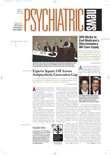Psychiatry stands unique among the medical specialties in its enormous potential for advancement. Over the past several decades, the field has undergone significant change. Since DSM-III was published in 1980, disorders have been defined in terms of descriptive syndromes rather than hypothetical but unproven theories. As we approach publication of DSM-V, scheduled for around 2011, research on psychiatric disorders is being studied closely.
The first phase of the DSM-V research planning process was commissioning a series of “white papers” highlighting research areas that could lead to classification-system improvements. In several conferences from now until 2007, literature and data will be reviewed and then referred to specialized DSM-V work groups.
Nomenclature in future classifications is expected to differ from that in DSM-IV. Additions or deletions of disorders and subtypes will be governed with a greater emphasis on clinical or etiologic validity. The current classification of psychiatric disorders implies that they are discrete diagnostic categories. Research will have to determine whether some disorders are better explained by a “dimensional” model, indicating that they merge imperceptibly both into one another and into normality. Such a diagnostic system may initially be applied to characterizing personality traits, and several models for rating aspects of personality have been proposed for clinical use.
With the exception of mental retardation and learning disorders, standardized rating scales have limited roles in diagnosis. However, as psychological assessments evolve, their validity and reliability may surpass those of the current criteria sets, which are based on clinical observation. These changes could facilitate detection and treatment of mild or subthreshold cases of certain disorders.
The current descriptive classifications define diagnostic entities that are undoubtedly heterogenous from both an etiologic and genetic perspective. Alternative strategies for increasing diagnostic homogeneity include the identification of genetically distinct diagnostic subtypes. For example, one research team analyzed a “periodic catatonia subtype” of schizophrenia and found significant evidence of linkage to a specific gene locus.
Genetic research may also be useful in refining clinical subtypes via the identification and analysis of intermediate phenotypes (for example, biological traits that index genetic liability to mental disorders). Studies of mRNA expression across critical brain regions from postmortem studies could make it possible to refine diagnostic systems as a function of the neural systems modified.
Pharmacodynamic differences may also help define new disease subtypes. Genetic variation could enable psychiatrists to predict which patients are likely to exhibit a positive therapeutic response or to be at higher risk for adverse events.
An important new direction is the use of imaging methods in conjunction with modern genetic methods, with the goal of identifying endophenotypes—patterns of brain structure or function that can be linked to a particular genotype.
Brain imaging studies promise to have the resolution and the chemical specificity to study relevant pathophysiological mechanisms. One important advance in structural imaging is the development of “tensor diffusion imaging,” which is sensitive to the direction of proton diffusion. Because diffusion is greatest along the axonal axis, this method can be used to trace neuronal fiber tracts. As these methods are refined and validated, they will significantly improve neuroanatomical studies.
Longitudinal neuroimaging studies, conducted over different time points, can also be important to specify further diagnostic categorization. For example, two divergent mechanisms may underlie two different cases currently classified as major depression, such as a neurodevelopmental and a later onset variety.
It is likely that integration of cross-modality imaging data (for example, structural and functional MRI) will result in clearer specification of pathophysiology associated with psychiatric disorders.
Ideally, the presence of disability should not govern the determination of the presence of a mental disorder. Removing the requirement for impairment from diagnostic criteria (as in other medical conditions, like hypertension or hypercholesterolemia) may encourage early intervention for those at risk of future morbidity.
The need for distinction between Axis I and Axis II will be a major focus of future research. Antisocial personality disorder and conduct disorder existing on separate axes appear inconsistent with evidence of continuity, for example. Cluster B symptoms often appear to merge with those of Axis I mood disorders. Future axial separation could emphasize alternative variables, perhaps genotype, biological phenotype, behavior, environmental modifiers, and disability.
To foster cross-cultural applicability of DSM, the diagnostic criteria will have to be applicable to all societies and cultures by recognizing cultural variants of symptoms. The diagnostic criteria for DSM-IV and ICD-10 show some differences, but with international collaboration with each DSM-V committee, it might be possible to create a single definition for most disorders.
APA has created a Web site at<www.dsm5.org> to provide information about DSM-V development. You can register to receive e-mails and a newsletter about the process or make suggestions.
Research involvement by those in our field is fundamental for an improved classification system. Psychiatry has much more to offer, and we are fortunate to be part of this exciting phase of its evolution. ▪

